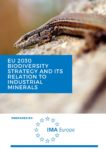EU 2030 Biodiversity Strategy and its Relation to Industrial Minerals
As part of the Natura 2000 network, the members of the IMA-Europe are actively seeking greater clarity, transparency, consistency in the processes by which areas of land are managed. EU’s ambition for the post-2020 global biodiversity framework and the Raw Materials Initiative should be used to underline the need to promote increased investment in the EU’s existing natural assets, with a stronger focus on quality than quantity of ecosystem services.
The sector takes great care to minimise the environmental and visible impact of its open-cast mine and quarry operations. Moreover, in terms of protecting nature, open surface mining often provides perfect conditions for unique habitat creation, especially for rare pioneer species, which thrive on the bare rocks and gravel of open-pit mines. Long term studies show that the biodiversity in open pit mining sites is even greater than in the surrounding area.
Industrial minerals companies have a full restoration plan at the very early permitting phase. This aim is to preserve and improve the ecosystem and fauna on-site during and after extraction.
Our industry undertakes to integrate the identification, evaluation and management of biodiversity into our business decision making processes and attempt to understand the diversity of species and the richness of ecosystems at future mining sites before embarking on any new mining projects. European Industrial Minerals Association preserves or promotes biodiversity throughout the operation’s lifetime at all our sites as far as possible.
Our sector needs to work in partnership with governments, communities, NGOs and other stakeholders on biodiversity. The industrial minerals sector has a track record of fruitful partnerships with people living near extraction sites. Operators want to encourage dialogue to foster a mutual understanding of the communities’ expectations and of the environmental and economic benefits that mining and quarrying projects can bring to local communities.
